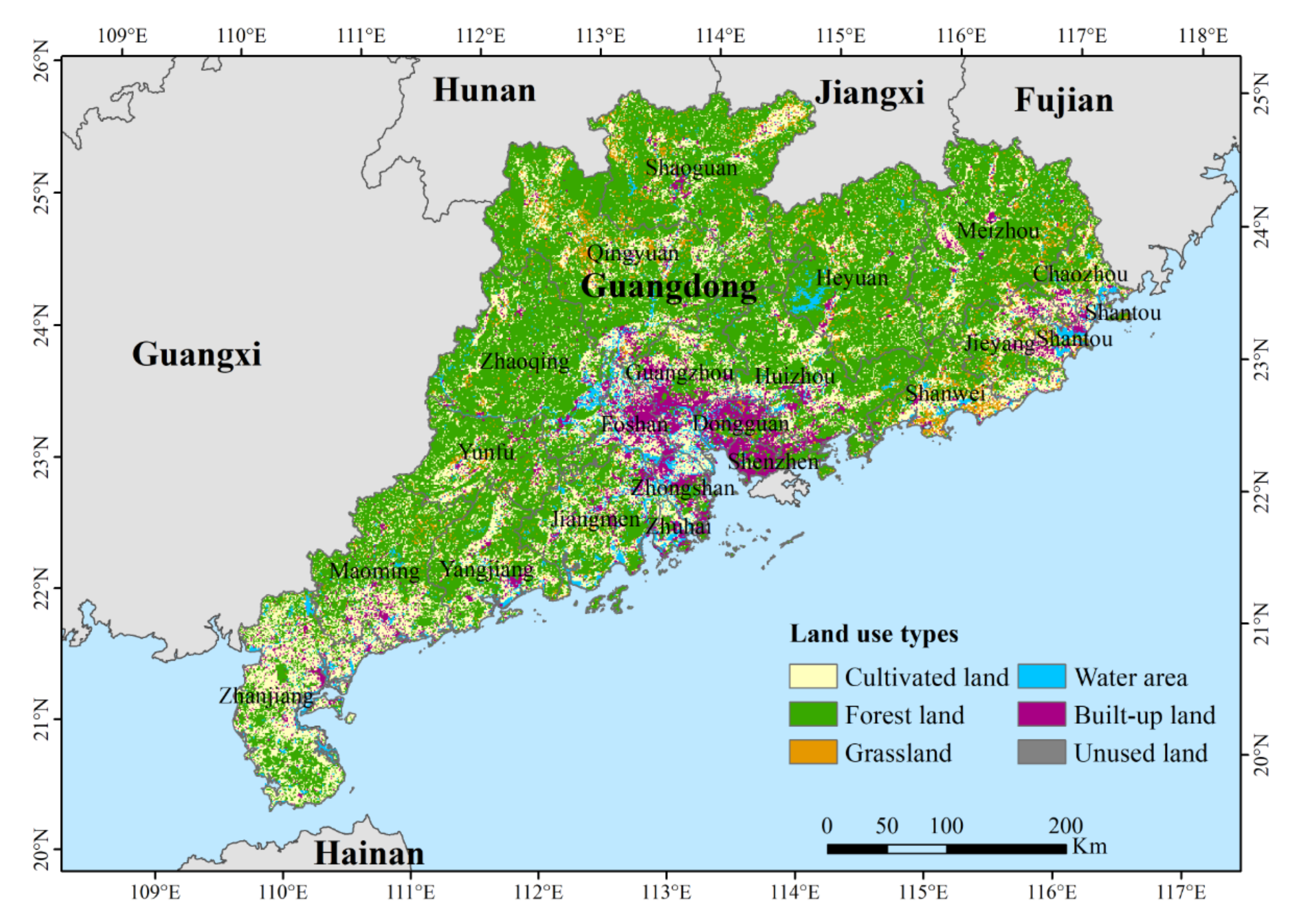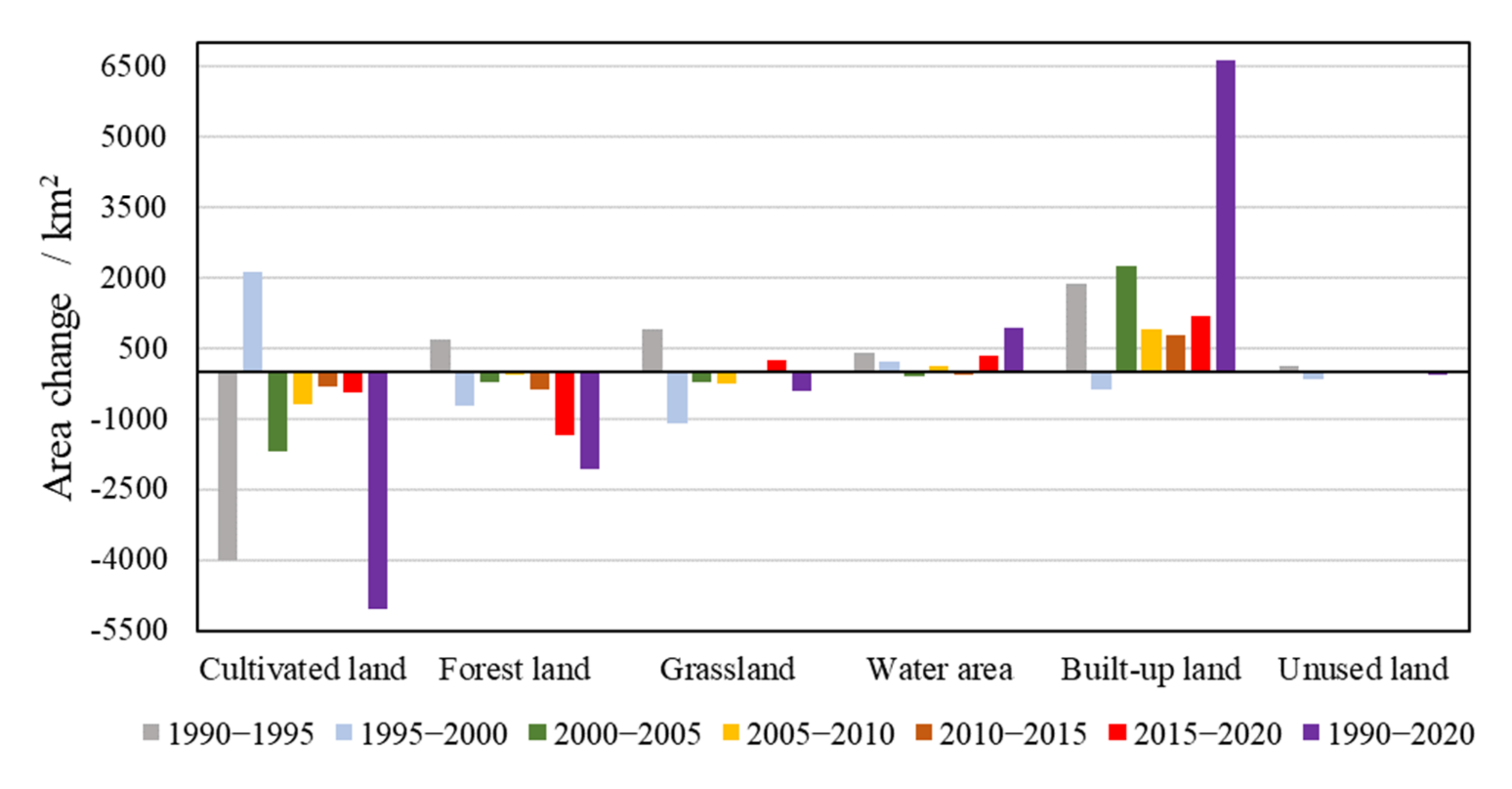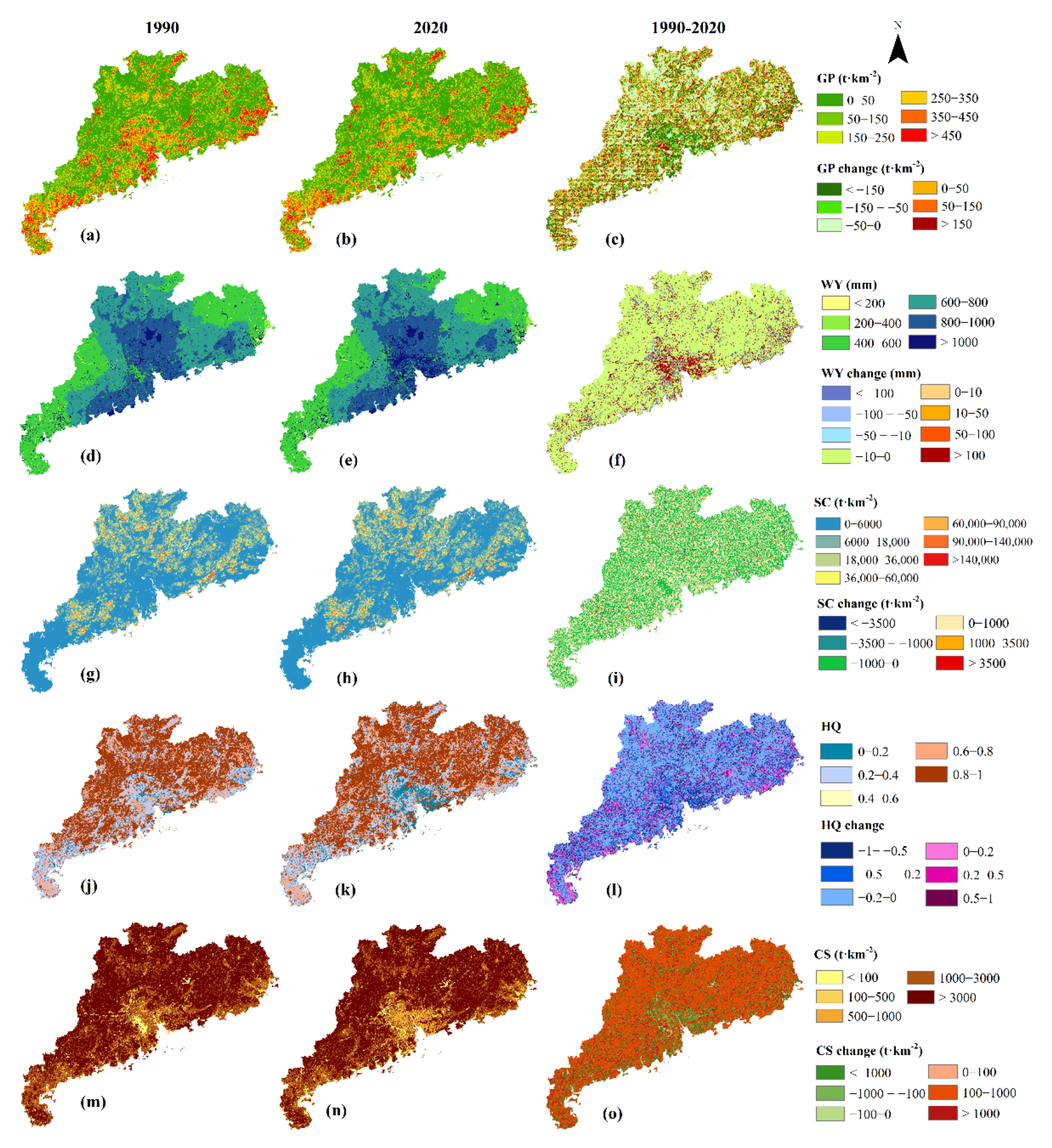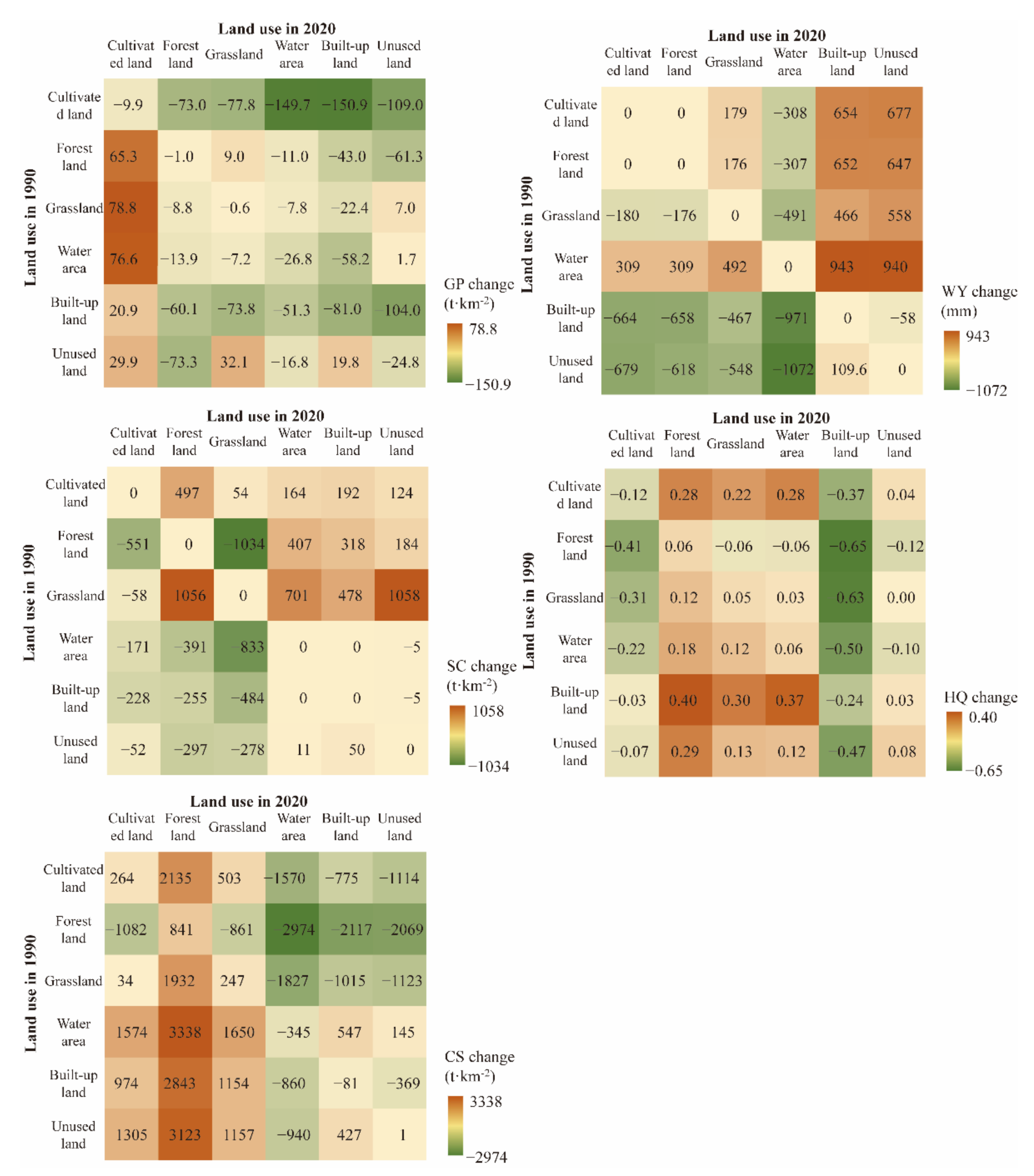Impacts of Historical Land Use Changes on Ecosystem Services in Guangdong Province, China
Abstract
:1. Introduction
2. Materials and Methods
2.1. Study Area
2.2. Data
2.3. Methods
2.3.1. Calculation of Grain Production
2.3.2. Calculation of Water Yield
2.3.3. Calculation of Soil Conservation
2.3.4. Calculation of Habitat Quality
2.3.5. Calculation of Carbon Sequestration
3. Results
3.1. Land Use Changes in Guangdong Province from 1990 to 2020
3.1.1. Characteristics of Land Use Pattern in Guangdong Province
3.1.2. Analysis of Land Use Changes in Guangdong Province
3.2. Changes of Ecosystem Services in Guangdong Province from 1990 to 2020
3.2.1. Changes of Grain Production
3.2.2. Changes of Water Yield
3.2.3. Changes of Soil Conservation
3.2.4. Changes of Habit Quality
3.2.5. Changes of Carbon Sequestration
3.3. Impact of Land Use Change on Ecosystem Services
4. Discussion
5. Conclusions
Author Contributions
Funding
Institutional Review Board Statement
Informed Consent Statement
Data Availability Statement
Acknowledgments
Conflicts of Interest
References
- Cochran, F.; Daniel, J.; Jackson, L.; Neale, A. Earth observation-based ecosystem services indicators for national and subnational reporting of the sustainable development goals. Remote Sens. Environ. 2020, 244, 111796. [Google Scholar] [CrossRef] [PubMed]
- Deng, X.; Li, Z.; Gibson, J. A review on trade-off analysis of ecosystem services for sustainable land-use management. J. Geogr. Sci. 2016, 26, 953–968. [Google Scholar] [CrossRef] [Green Version]
- Zheng, H.; Wang, L.; Peng, W.; Zhang, C.; Li, C.; Robinson Brian, E.; Wu, X.; Kong, L.; Li, R.; Xiao, Y.; et al. Realizing the values of natural capital for inclusive, sustainable development: Informing China’s new ecological development strategy. Proc. Natl. Acad. Sci. USA 2019, 116, 8623–8628. [Google Scholar] [CrossRef] [PubMed] [Green Version]
- Peng, K.; Jiang, W.; Ling, Z.; Hou, P.; Deng, Y. Evaluating the potential impacts of land use changes on ecosystem service value under multiple scenarios in support of SDG reporting: A case study of the Wuhan urban agglomeration. J. Clean. Prod. 2021, 307, 127321. [Google Scholar] [CrossRef]
- Schäfer, R.B.; Bundschuh, M.; Rouch, D.A.; Szöcs, E.; Peter, C.; Pettigrove, V.; Schulz, R.; Nugegoda, D.; Kefford, B.J. Effects of pesticide toxicity, salinity and other environmental variables on selected ecosystem functions in streams and the relevance for ecosystem services. Sci. Total Environ. 2012, 415, 69–78. [Google Scholar] [CrossRef]
- Arowolo, A.O.; Deng, X.; Olatunji, O.A.; Obayelu, A.E. Assessing changes in the value of ecosystem services in response to land-use/land-cover dynamics in Nigeria. Sci. Total Environ. 2018, 636, 597–609. [Google Scholar] [CrossRef]
- Deng, X.; Huang, J.; Rozelle, S.; Zhang, J.; Li, Z. Impact of urbanization on cultivated land changes in China. Land Use Policy 2015, 45, 1–7. [Google Scholar] [CrossRef]
- Mononen, L.; Auvinen, A.P.; Ahokumpu, A.L.; Rönkä, M.; Aarras, N.; Tolvanen, H.; Kamppinen, M.; Viirret, E.; Kumpula, T.; Vihervaara, P. National ecosystem service indicators: Measures of social–ecological sustainability. Ecol. Indic. 2016, 61, 27–37. [Google Scholar] [CrossRef]
- Fugère, V.; Nyboer, E.A.; Bleecker, J.C.; Chapman, L.J. Impacts of forest loss on inland waters: Identifying critical research zones based on deforestation rates, aquatic ecosystem services, and past research effort. Biol. Conserv. 2016, 201, 277–283. [Google Scholar] [CrossRef]
- McGlue, M.M.; Yeager, K.M.; Soreghan, M.J.; Behm, M.; Kimirei, I.A.; Cohen, A.S.; Apse, C.; Limbu, P.; Smiley, R.A.; Doering, D.; et al. Spatial variability in nearshore sediment pollution in Lake Tanganyika (East Africa) and implications for fisheries conservation. Anthropocene 2021, 33, 100281. [Google Scholar] [CrossRef]
- Cardinale, B.J.; Duffy, J.E.; Gonzalez, A.; Hooper, D.U.; Perrings, C.; Venail, P.; Narwani, A.; Mace, G.M.; Tilman, D.; Wardle, D.A.; et al. Biodiversity loss and its impact on humanity. Nature 2012, 486, 59–67. [Google Scholar] [CrossRef] [PubMed]
- Mu, H.; Li, X.; Ma, H.; Du, X.; Huang, J.; Su, W.; Yu, Z.; Xu, C.; Liu, H.; Yin, D.; et al. Evaluation of the policy-driven ecological network in the Three-North Shelterbelt region of China. Landsc. Urban Plan. 2022, 218, 104305. [Google Scholar] [CrossRef]
- United Nations. Transforming Our World: The 2030 Agenda for Sustainable Development; United Nations, Department of Economic and Social Affairs: New York, NY, USA, 2015. [Google Scholar]
- Liu, W.; Zhan, J.; Zhao, F.; Yan, H.; Zhang, F.; Wei, X. Impacts of urbanization-induced land-use changes on ecosystem services: A case study of the Pearl River Delta Metropolitan Region, China. Ecol. Indic. 2019, 98, 228–238. [Google Scholar] [CrossRef]
- Cai, Y.; Zhang, H.; Pan, W.; Chen, Y.; Wang, X. Land use pattern, socio-economic development, and assessment of their impacts on ecosystem service value: Study on natural wetlands distribution area (NWDA) in Fuzhou city, southeastern China. Environ. Monit. Assess. 2013, 185, 5111–5123. [Google Scholar] [CrossRef]
- Polasky, S.; Nelson, E.; Pennington, D.; Johnson, K.A. The impact of land-use change on ecosystem services, biodiversity and returns to landowners: A case study in the state of Minnesota. Environ. Resour. Econ. 2011, 48, 219–242. [Google Scholar] [CrossRef]
- Xie, L.; Wang, H.; Liu, S. The ecosystem service values simulation and driving force analysis based on land use/land cover: A case study in inland rivers in arid areas of the Aksu River Basin, China. Ecol. Indic. 2022, 138, 108828. [Google Scholar] [CrossRef]
- Hoque, M.Z.; Islam, I.; Ahmed, M.; Hasan, S.S.; Prodhan, F.A. Spatio-temporal changes of land use land cover and ecosystem service values in coastal Bangladesh. Egypt. J. Remote Sens. Space Sci. 2022, 25, 173–180. [Google Scholar] [CrossRef]
- Morshed, S.R.; Fattah, M.A.; Haque, M.N.; Morshed, S.Y. Future ecosystem service value modeling with land cover dynamics by using machine learning based Artificial Neural Network model for Jashore city, Bangladesh. Phys. Chem. Earth Parts A/B/C 2021, 126, 103021. [Google Scholar] [CrossRef]
- Grafius, D.R.; Corstanje, R.; Warren, P.H.; Evans, K.L.; Hancock, S.; Harris, J.A. The impact of land use/land cover scale on modelling urban ecosystem services. Landsc. Ecol. 2016, 31, 1509–1522. [Google Scholar] [CrossRef] [Green Version]
- Boavida-Portugal, I.; Rocha, J.; Ferreira, C.C. Exploring the impacts of future tourism development on land use/cover changes. Appl. Geogr. 2016, 77, 82–91. [Google Scholar] [CrossRef]
- Romano, G.; Dal Sasso, P.; Liuzzi, G.T.; Gentile, F. Multi-criteria decision analysis for land suitability mapping in a rural area of Southern Italy. Land Use Policy 2015, 48, 131–143. [Google Scholar] [CrossRef]
- Sharma, R.; Nehren, U.; Rahman, S.A.; Meyer, M.; Rimal, B.; Aria Seta, G.; Baral, H. Modeling land use and land cover changes and their effects on biodiversity in Central Kalimantan, Indonesia. Land 2018, 7, 57. [Google Scholar] [CrossRef] [Green Version]
- Alkemade, R.; Van Oorschot, M.; Miles, L.; Nellemann, C.; Bakkenes, M.; Ten Brink, B. GLOBIO3: A framework to investigate options for reducing global terrestrial biodiversity loss. Ecosystems 2009, 12, 374–390. [Google Scholar] [CrossRef] [Green Version]
- Gao, J.; Li, F.; Gao, H.; Zhou, C.; Zhang, X. The impact of land-use change on water-related ecosystem services: A study of the Guishui River Basin, Beijing, China. J. Clean. Prod. 2017, 163, S148–S155. [Google Scholar] [CrossRef]
- Daily, G.C.; Polasky, S.; Goldstein, J.; Kareiva, P.M.; Mooney, H.A.; Pejchar, L.; Ricketts, T.H.; Salzman, J.; Shallenberger, R. Ecosystem services in decision making: Time to deliver. Front. Ecol. Environ. 2009, 7, 21–28. [Google Scholar] [CrossRef] [Green Version]
- Yang, J.; Tan, Y.; Xue, D. The impacts of globalization on city environments in developing countries: A case study of 21 cities in Guangdong Province, China. J. Clean. Prod. 2019, 240, 118273. [Google Scholar] [CrossRef]
- Wang, J.; Wang, S.; Li, S.; Feng, K. Coupling analysis of urbanization and energy-environment efficiency: Evidence from Guangdong province. Appl. Energy 2019, 254, 113650. [Google Scholar] [CrossRef]
- Nachtergaele, F.; Velthuizen, H.; Verelst, L.; Wiberg, D. Harmonized World Soil Database (HWSD); Food and Agriculture Organization of the United Nations: Rome, Italy, 2009. [Google Scholar]
- Liu, W.; Zhan, J.; Zhao, F.; Wang, C.; Zhang, F.; Teng, Y.; Chu, X.; Kumi, M.A. Spatio-temporal variations of ecosystem services and their drivers in the Pearl River Delta, China. J. Clean. Prod. 2022, 337, 130466. [Google Scholar] [CrossRef]
- Ye, Y.; Zhang, J.; Wang, T.; Bai, H.; Wang, X.; Zhao, W. Changes in land-use and ecosystem service value in guangdong province, southern China, from 1990 to 2018. Land 2021, 10, 426. [Google Scholar] [CrossRef]
- Rimal, B.; Sharma, R.; Kunwar, R.; Keshtkar, H.; Stork, N.E.; Rijal, S.; Rahman, S.A.; Baral, H. Effects of land use and land cover change on ecosystem services in the Koshi River Basin, Eastern Nepal. Ecosyst. Serv. 2019, 38, 100963. [Google Scholar] [CrossRef]
- Deng, C.; Zhu, D.; Nie, X.; Liu, C.; Zhang, G.; Liu, Y.; Li, Z.; Wang, S.; Ma, Y. Precipitation and urban expansion caused jointly the spatiotemporal dislocation between supply and demand of water provision service. J. Environ. Manag. 2021, 299, 113660. [Google Scholar] [CrossRef] [PubMed]
- Yin, C.; Zhao, W.; Pereira, P. Soil conservation service underpins sustainable development goals. Glob. Ecol. Conserv. 2022, 33, e01974. [Google Scholar] [CrossRef]
- Terrado, M.; Sabater, S.; Chaplin-Kramer, B.; Mandle, L.; Ziv, G.; Acuña, V. Model development for the assessment of terrestrial and aquatic habitat quality in conservation planning. Sci. Total Environ. 2016, 540, 63–70. [Google Scholar] [CrossRef] [PubMed] [Green Version]
- Liang, Y.; Hashimoto, S.; Liu, L. Integrated assessment of land-use/land-cover dynamics on carbon storage services in the Loess Plateau of China from 1995 to 2050. Ecol. Indic. 2021, 120, 106939. [Google Scholar] [CrossRef]
- Garrastazú, M.C.; Mendonça, S.D.; Horokoski, T.T.; Cardoso, D.J.; Rosot, M.A.; Nimmo, E.R.; Lacerda, A.E. Carbon sequestration and riparian zones: Assessing the impacts of changing regulatory practices in Southern Brazil. Land Use Policy 2015, 42, 329–339. [Google Scholar] [CrossRef]
- Stockmann, U.; Adams, M.A.; Crawford, J.W.; Field, D.J.; Henakaarchchi, N.; Jenkins, M.; Minasny, B.; McBratney, A.B.; Courcelles, V.d.R.d.; Singh, K.; et al. The knowns, known unknowns and unknowns of sequestration of soil organic carbon. Agric. Ecosyst. Environ. 2013, 164, 80–99. [Google Scholar] [CrossRef]
- Güner, Ş.T.; Erkan, N.; Karataş, R. Effects of afforestation with different species on carbon pools and soil and forest floor properties. Catena 2021, 196, 104871. [Google Scholar] [CrossRef]
- Tasser, E.; Schirpke, U.; Zoderer, B.M.; Tappeiner, U. Towards an integrative assessment of land-use type values from the perspective of ecosystem services. Ecosyst. Serv. 2020, 42, 101082. [Google Scholar] [CrossRef]
- Hasan, S.S.; Zhen, L.; Miah, M.G.; Ahamed, T.; Samie, A. Impact of land use change on ecosystem services: A review. Environ. Dev. 2020, 34, 100527. [Google Scholar] [CrossRef]
- Díaz, S.; Demissew, S.; Carabias, J.; Joly, C.; Lonsdale, M.; Ash, N.; Larigauderie, A.; Adhikari, J.R.; Arico, S.; Báldi, A. The IPBES Conceptual Framework—connecting nature and people. Curr. Opin. Environ. Sustain. 2015, 14, 1–16. [Google Scholar] [CrossRef] [Green Version]
- Gómez-Baggethun, E.; Barton, D.N. Classifying and valuing ecosystem services for urban planning. Ecol. Econ. 2013, 86, 235–245. [Google Scholar] [CrossRef]
- Silvestri, S.; Zaibet, L.; Said, M.Y.; Kifugo, S.C. Valuing ecosystem services for conservation and development purposes: A case study from Kenya. Environ. Sci. Policy 2013, 31, 23–33. [Google Scholar] [CrossRef]






| Data | Description | Data Source |
|---|---|---|
| Land use | Land use in 1990, 1995, 2000, 2005, 2010, 2015 and 2020 with a resolution of 1 km. | The Data Center for Resources and Environmental Sciences, Chinese Academy of Sciences (http://www.resdc.cn/) (accessed on 12 March 2022). |
| Topography data | Digital elevation model (DEM) with a resolution of 1 km. | |
| Meteorological data | Daily meteorological data, including precipitation, temperature, evapotranspiration, and solar radiation etc., during 1990–2020 | The National Meteorological Information Center (http://data.cma.cn/) (accessed on 14 February 2022) |
| Soil tyeps and properties | Soil data, including soil depth, clay content, silt content, sand content, clay content, organic carbon content, gravel content, and electrical conductivity, with a resolution of 1 km. | The Harmonized World Soil Database [29]. |
| Grain production data | Grain production per unit area of cities in Guangdong province from 2013 to 2020 | Statistical Yearbook of Guangdong Province |
| Ecosystem Services | Description |
|---|---|
| Grain production (GP) | GP is one of the most basic supply services of ecosystem and provides material guarantee for human survival and development [32]. |
| Water yield (WY) | The provision of freshwater is one of the ecosystem service functions that plays a crucial role in promoting biological survival and ensuring ecological security [33]. |
| Soil conservation (SC) | SC is one of the important ecosystem services, representing the ability of ecosystems to protect soil and control erosion [34]. |
| Habitat quality (HQ) | Biodiversity is closely linked to the production of ecosystem services, and HQ is an expression of the ability of ecosystems to provide permanent living conditions for organisms [35]. |
| Carbon sequestration (CS) | CS is considered as one of the most critical ecosystem services for assessing the response of productive capacity and ecological resilience to climate change [36]. |
| Land Use Type | 1990 | 2020 | 1990–2020 | ||
|---|---|---|---|---|---|
| Area (km2) | Percentage (%) | Area (km2) | Percentage (%) | Amount and Rate of Change (km2/%) | |
| Cultivated land | 47,236 | 26.65 | 42,199 | 23.81 | −5037 (−10.7) |
| Forest land | 108,175 | 61.03 | 106,110 | 59.87 | −2065 (−1.9) |
| Grassland | 8010 | 4.52 | 7605 | 4.29 | −405 (−5.1) |
| Water areas | 6856 | 3.87 | 7797 | 4.40 | 941 (13.7) |
| Built-up land | 6780 | 3.83 | 13,417 | 7.57 | 6637 (97.9) |
| Unused land | 183 | 0.10 | 112 | 0.06 | −71 (−38.8) |
Publisher’s Note: MDPI stays neutral with regard to jurisdictional claims in published maps and institutional affiliations. |
© 2022 by the authors. Licensee MDPI, Basel, Switzerland. This article is an open access article distributed under the terms and conditions of the Creative Commons Attribution (CC BY) license (https://creativecommons.org/licenses/by/4.0/).
Share and Cite
Chen, H.; Chen, Y.; Chen, X.; Zhang, X.; Wu, H.; Li, Z. Impacts of Historical Land Use Changes on Ecosystem Services in Guangdong Province, China. Land 2022, 11, 809. https://doi.org/10.3390/land11060809
Chen H, Chen Y, Chen X, Zhang X, Wu H, Li Z. Impacts of Historical Land Use Changes on Ecosystem Services in Guangdong Province, China. Land. 2022; 11(6):809. https://doi.org/10.3390/land11060809
Chicago/Turabian StyleChen, Haizhen, Yi Chen, Xiaosong Chen, Xingzhong Zhang, Haowei Wu, and Zhihui Li. 2022. "Impacts of Historical Land Use Changes on Ecosystem Services in Guangdong Province, China" Land 11, no. 6: 809. https://doi.org/10.3390/land11060809
APA StyleChen, H., Chen, Y., Chen, X., Zhang, X., Wu, H., & Li, Z. (2022). Impacts of Historical Land Use Changes on Ecosystem Services in Guangdong Province, China. Land, 11(6), 809. https://doi.org/10.3390/land11060809







